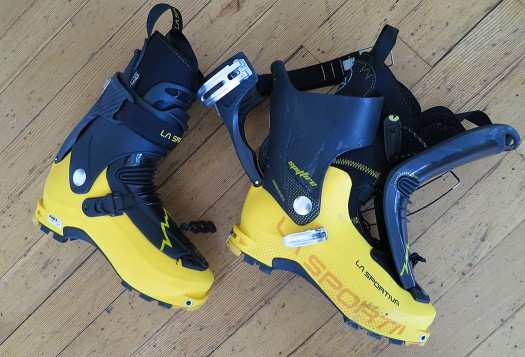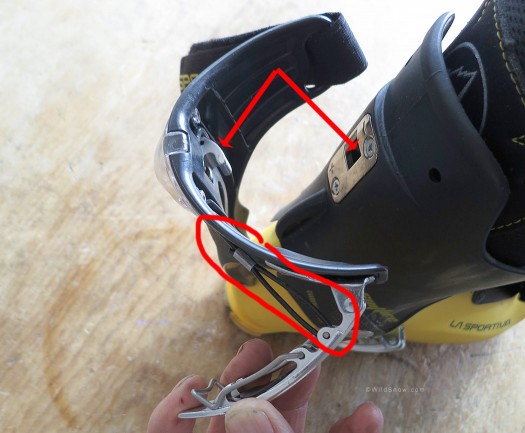Most of the money and plastic in the AT boot industry goes for war material in the battle of the beef boot. Sometimes cast concrete is appropriate for your feet, but I’ll come out and say it: Helmet cams and TGR fantasies aside, most of the backcountry skiing done around the world requires nothing more than a good quality lightweight-class AT ski boot. If you need otherwise, you know who you are. In that case just laugh at my bias (or groan). Otherwise, read on — Sportiva Spitfire might be a boot option for you.

My Spitfire testers. Small appendage on lower tongue is my add-on attachment for safety strap done by drilling a hole through tongue. Ignore.
(First, rather than publishing a bunch of redundant photos, please see our first-look for photos of Spitfire features. Then read on.)
Thing is, while backcountry capable ski boots have become the George Foreman Grill of the snow sports industry, look for a one-motion mode change boot at around 1,200 grams each and you’ll only find a few offerings out there. Indeed, that’s part of the reason you see one brand/model of ski boot dominating the market in places where folks put a premium on comfort, distance, and vertical.
Why we don’t we see more boot brands producing in the highly engineered 1,200 gram class? My guess is that it’s actually a lot easier to design and make a basic overlap cuff or tongue boot with three or four buckles and a steel rod walk-mode cuff latch. Yeah, models available in those backcountry skiing boots have nice engineering — but so do Foreman Grills — and most of such products are about the same today as they were twenty years ago. In comparison, The 1,200 gram ski boots with innovative cuff latches, short BSLs and amazingly low volume shells are newborns.
I’ve skied the Spitfire quite a few times now. While they suffer the lack of progressive flex endemic to boots that depend on achieving stiffness by strapping your tibia to a backbone spoiler, Spitfire are, yes, stiff. Surprisingly so. If you’re used to the feel and style required by this sort of ergonomics you’ll have no trouble with Spitfire, but if you come from a bigger shoe that flexes smoother be ready for a transition. Key is to think about achieving the most powerful neutral position possible. Adjust things like boot/binding ramp angle and cuff lean to achieve that, as with this sort of boot it’s tougher to just drive your knees forward and adjust your position on the fly. (In terms of factory cuff lean angle, yes, this IS adjustable by swapping a small metal plate on the inside spoiler.)
Boot fit is not usually a big issue for us in reviews. In fact, I usually advise our guest bloggers to be aware that all feet are different, and to not focus their writing on the fit they personally got from a boot (which is sometimes the easiest most experiential thing to write about, but the least likely to transfer to other people.)
Nonetheless, a few things about the Spitfire fit deserve mention. Mainly, this could be the lowest volume boot I’ve ever worked with. That means a tight and responsive fit are a given; you may find yourself with mandatory punching and tweaking to get a fit. If you’re mail ordering, be sure to do a thorough carpet fit and shell sizing evaluation before you toss the shipping box — if in doubt consult a boot fitter. Better, buy retail at a brick-and-mortar where you can fit multiple sizes and spend some time walking around (again, be sure an in-house boot fitter is available to help evaluate).

Hook indicated by arrows catches slot in spoiler, is retracted and released by moving the buckle as indicated, which pulls the cable. Quite ingenious and works reliably.
The other big deal with Spitfire is the one-motion cuff lock. Rather than a simple (yet effective) tang inserting into a hole as the other brand uses, Spitfire has an ingenious hook-like device that catches a hole in the rear spoiler to lock for downhill mode. This being somewhat more mechanically complex than other methods I paid particular attention to its reliability. Pass on that. The latch engaged every time as required, never caught accidentally, and supplied a solid feeling on the downhill. (Note that cuff lean is adjustable by swapping the metal plate on the rear spoiler; parts included in the retail box.)
As alluded to above, Spitfire (Palau manufactured) liner is thin. It is really little more than a foam sock. In a good way. No extra weight here, and a nice compact lacing system that involves pre-adjusting your lace length then simply sticking a velcro tab when you’re putting your boots on. Super smart, and the lacing system is totally removable if you prefer.
What else? Weight of Spitfire is feather category: My size 27.5 with aftermarket footbed and power strap removed weigh in at 43.4 ounces (1228 g) each. And check out the BSL: only 297 millimeters! A shorter boot is easier to dirt hike or alpine scramble in, and a bit more efficient for uphilling on skins. I noticed, especially while walking sans skis.
Conclusion: If you can get a fit in the Spitfire, its performance easily equals or surpasses other lightweight “one motion latching” boots on the market.
Give them a look if you’re shopping.
WildSnow.com publisher emeritus and founder Lou (Louis Dawson) has a 50+ years career in climbing, backcountry skiing and ski mountaineering. He was the first person in history to ski down all 54 Colorado 14,000-foot peaks, has authored numerous books about about backcountry skiing, and has skied from the summit of Denali in Alaska, North America’s highest mountain.
